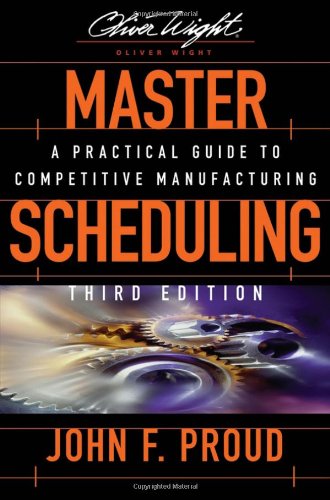Master Scheduling A Practical Guide to Competitive Manufacturing 3rd Edition by John F Proud ISBN 0471757276 9780471757276 by John F. Proud 9780471757276, 0471757276 instant download after payment.
Master Scheduling A Practical Guide to Competitive Manufacturing 3rd Edition by John F Proud - Ebook PDF Instant Download/Delivery: 0471757276, 9780471757276
Full download Master Scheduling A Practical Guide to Competitive Manufacturing 3rd Edition after payment

Product details:
ISBN 10: 0471757276
ISBN 13: 9780471757276
Author: John F Proud
Master Scheduling A Practical Guide to Competitive Manufacturing 3rd Table of contents:
Part I: Understanding the Foundation
Chapter 1: The Business Environment and the Need for Master Scheduling
- 1.1 The Competitive Manufacturing Landscape
- 1.2 Introduction to Integrated Business Planning (IBP) / Sales & Operations Planning (S&OP)
- 1.3 The Role of Master Scheduling within the Planning Hierarchy
- 1.4 Linkages to Demand Management, Production Planning, and MRP
- 1.5 Common Challenges Without Effective Master Scheduling
Chapter 2: Core Concepts of Master Scheduling
- 2.1 What is a Master Schedule? (MPS - Master Production Schedule, MMS - Master Manufacturing Schedule)
- 2.2 Key Inputs: Demand Forecasts, Production Plan, Resource Availability
- 2.3 Key Outputs: Build Plan, Available-to-Promise (ATP), Capable-to-Promise (CTP)
- 2.4 Time Fences: Planning, Demand, and Frozen Zones
- 2.5 Aggregate vs. Detailed Planning
Part II: Building the Master Schedule
Chapter 3: Demand Management for Master Scheduling
- 3.1 Understanding Different Types of Demand (Independent, Dependent, Customer Orders, Forecasts)
- 3.2 Effective Forecasting Techniques for MPS
- 3.3 Managing Demand Volatility and Seasonality
- 3.4 Collaborative Forecasting with Sales and Marketing
- 3.5 Dealing with Promotions and New Product Introductions
Chapter 4: Developing the Initial Master Schedule
- 4.1 Steps in Creating the Master Production Schedule (MPS)
- 4.2 Rough-Cut Capacity Planning (RCCP): Validating Feasibility
- 4.3 Building the MPS for Make-to-Stock, Make-to-Order, and Assemble-to-Order Environments
- 4.4 Using Planning Bills of Material and Option Percentages
- 4.5 The Role of Product Families and End Items
Chapter 5: Capacity Planning for Master Scheduling
- 5.1 Understanding Different Levels of Capacity Planning (Resource Planning, RCCP, CRP)
- 5.2 Performing Rough-Cut Capacity Planning (RCCP)
- 5.3 Identifying Bottlenecks and Constraints
- 5.4 Strategies for Resolving Capacity Imbalances (Overtime, Subcontracting, Inventory)
- 5.5 Linking Capacity to the Sales and Operations Plan
Part III: Managing and Refining the Master Schedule
Chapter 6: Master Schedule Execution and Control
- 6.1 Executing the MPS: The Role of Materials Requirements Planning (MRP)
- 6.2 Monitoring Performance Against the Schedule
- 6.3 Responding to Disruptions and Changes (Expediting, De-Expediting)
- 6.4 The Importance of Data Accuracy and Integrity
- 6.5 The Master Production Scheduler's Role and Responsibilities
Chapter 7: Available-to-Promise (ATP) and Capable-to-Promise (CTP)
- 7.1 Understanding Available-to-Promise (ATP) Logic
- 7.2 Using ATP for Order Promising and Customer Service
- 7.3 Introduction to Capable-to-Promise (CTP)
- 7.4 Integrating ATP/CTP with Sales Order Entry and Customer Relationship Management
Chapter 8: Master Scheduling in Different Manufacturing Environments
- 8.1 Process Manufacturing (e.g., Food, Chemicals)
- 8.2 Discrete Manufacturing (e.g., Automotive, Electronics)
- 8.3 Project-Based Manufacturing
- 8.4 Engineer-to-Order (ETO) and Configure-to-Order (CTO) Environments
- 8.5 Integrating Services into the Master Schedule
Part IV: Advanced Topics and Implementation
Chapter 9: Performance Measurement and Metrics for Master Scheduling
- 9.1 Key Performance Indicators (KPIs) for MPS Effectiveness
- 9.2 Measuring Schedule Stability and Adherence
- 9.3 Forecast Accuracy and Bias
- 9.4 Inventory Turns and Customer Service Levels
- 9.5 Root Cause Analysis of Performance Gaps
Chapter 10: People, Process, and Technology for Successful Master Scheduling
- 10.1 The Role of People: Training, Communication, and Collaboration
- 10.2 Establishing Clear Processes and Policies
- 10.3 Leveraging Technology: ERP Systems and Specialized Planning Software
- 10.4 Data Management and Master Data Governance
- 10.5 Building a Culture of Disciplined Execution
Chapter 11: Implementing and Sustaining Master Scheduling Excellence
- 11.1 Project Management for MPS Implementation
- 11.2 Change Management Strategies
- 11.3 Pilot Programs and Phased Rollouts
- 11.4 Continuous Improvement and Auditing (e.g., Oliver Wight Class A Checklist)
- 11.5 Overcoming Common Implementation Pitfalls
Conclusion: The Master Scheduler as a Strategic Driver
- The Evolving Role of Master Scheduling
- Achieving Competitive Advantage Through Integrated Planning
- Final Thoughts on Sustaining Excellence
People also search for Master Scheduling A Practical Guide to Competitive Manufacturing 3rd:
master scheduling: a practical guide
master scheduling a practical guide to competitive manufacturing
master scheduling best practices
master scheduling process
master scheduling example
Tags: John F Proud, Master, Scheduling



